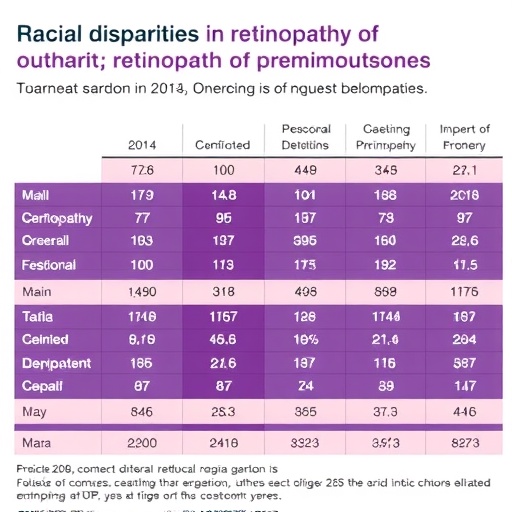
In a groundbreaking new study published in the Journal of Perinatology, researchers have unveiled critical insights into racial disparities affecting infants diagnosed with retinopathy of prematurity (ROP), a potentially blinding eye disease primarily impacting premature babies. This extensive investigation not only highlights significant variations in the incidence of ROP requiring treatment among different racial groups but also delves into the complex treatment patterns and clinical outcomes tied to these disparities. As neonatal care advances, understanding such differences has never been more urgent to ensure equitable healthcare delivery and improve prognoses for the most vulnerable newborns.
ROP is a proliferative vascular disorder caused by abnormal retinal blood vessel development in premature infants. The condition can progress rapidly, leading to retinal detachment and permanent vision loss if untreated. Historically, ROP incidence has been linked to gestational age, birth weight, and oxygen exposure; however, emerging evidence points to race and ethnicity as crucial but understudied elements influencing disease progression and management outcomes. The new study spearheaded by Drs. Jacob and Arnold methodically investigated treatment-requiring ROP across diverse populations, unveiling disparities that may illuminate previously unrecognized pathways of disease vulnerability.
Utilizing a robust dataset comprising thousands of premature infants evaluated over several years, the study scrutinized demographic, clinical, and treatment variables to paint a comprehensive portrait of racial differences in disease presentation and therapeutic intervention. Notably, the findings uncovered that specific racial groups exhibited disproportionate rates of ROP necessitating treatment, even after adjusting for traditional risk factors like gestational age and birth weight. This demographic variance calls into question existing assumptions about the homogeneity of risk factors and urges a reconsideration of individualized screening protocols tailored to racial backgrounds.
.adsslot_BeyPLGp4kV{width:728px !important;height:90px !important;}
@media(max-width:1199px){ .adsslot_BeyPLGp4kV{width:468px !important;height:60px !important;}
}
@media(max-width:767px){ .adsslot_BeyPLGp4kV{width:320px !important;height:50px !important;}
}
ADVERTISEMENT
Beyond incidence rates, the investigation revealed significant discrepancies in treatment modalities administered to affected infants. Standard treatments for ROP include laser photocoagulation and intravitreal anti-vascular endothelial growth factor (anti-VEGF) injections, both designed to halt abnormal retinal neovascularization. Intriguingly, the study showed that certain racial groups were more likely to receive one form of treatment over another, suggesting potential underlying biases or systematic differences in clinical decision-making. These patterns raise imperative questions about access, provider preferences, and institutional practices shaping neonatal care landscapes.
Moreover, the study explored the timing of interventions, recognizing that the window for effective treatment in ROP is narrow, and delays can have devastating consequences. Analyzing temporal aspects, researchers found subtle but meaningful differences in the ages at first treatment across racial cohorts. These variations might reflect disparities in early diagnosis, availability of specialized ophthalmologic care, or socioeconomic barriers impacting healthcare utilization. Such findings emphasize that racial disparities extend beyond the biological domain into structural and systemic arenas influencing health equity.
One of the most striking revelations from the study was the persistence of poorer visual outcomes in certain racial groups, despite receiving recommended treatments. This suggests that beyond treatment disparities, intrinsic biological differences or co-existing comorbidities might modulate disease severity or response to therapy. Alternatively, it may indicate gaps in post-treatment monitoring or rehabilitation services emphasizing the necessity for a holistic approach to neonatal ophthalmic care that considers racial and social determinants of health.
The researchers underscore the multifactorial nature of these disparities, advocating for multidisciplinary research integrating genetics, clinical practice, and social science perspectives. Genome-wide association studies and molecular investigations could unravel racial differences in angiogenic signaling pathways or inflammatory responses, enhancing precision medicine approaches tailored for at-risk populations. Concurrently, epidemiological efforts must intensify to map out environmental and socioeconomic contributors to disease progression and treatment accessibility.
In clinical practice, these revelations mandate heightened vigilance and possibly revised screening guidelines to capture at-risk infants earlier, especially within populations demonstrating elevated ROP severity or delayed treatment initiation. Neonatologists and pediatric ophthalmologists should collaborate closely with social workers and community healthcare providers to dismantle barriers to timely care. Resources ensuring equitable access to screening and treatment, such as mobile units or telemedicine programs, could play transformative roles in bridging existing gaps illuminated by this study.
Importantly, the study shines a light on the urgent need for inclusive clinical trials reflecting the diversity of neonatal populations. Historically, minority groups have been underrepresented in pediatric ophthalmologic research, limiting the generalizability of findings and potentially perpetuating disparities. By prioritizing diverse enrollment and culturally sensitive study designs, future work can generate actionable knowledge to mitigate racial inequities in ROP outcomes effectively.
The ramifications of ROP extend beyond infancy, with lifelong implications for visual function, educational achievement, and quality of life. Therefore, addressing disparities is not merely a clinical imperative but a societal one demanding coordinated policy interventions. Investing in neonatal healthcare infrastructure, promoting awareness among healthcare professionals about unconscious biases, and fostering community engagement are crucial steps toward achieving true equity in neonatal eye care.
The findings also evoke broader discussions about structural racism entrenched within healthcare systems, influencing everything from patient-provider interactions to allocation of resources. While neonatal medicine has made remarkable strides, this study reminds the medical community that progress must be intertwined with justice, ensuring that advancements benefit all infants regardless of race or background. The authors call for deliberate efforts in training, policy reform, and public health initiatives centered on dismantling these systemic barriers.
In conclusion, the work by Jacob and Arnold marks a seminal advance in understanding the intricate landscape of racial disparities in ROP. Their meticulous analyses provide a clarion call to research, clinical care, and health policy arenas. By highlighting not just differential incidence but also treatment patterns and outcomes, the study paints a nuanced picture demanding multifaceted responses. As neonatal survival rates rise globally, the imperative to ensure that every vulnerable infant has an equal chance at healthy sight is paramount, positioning this research at the vanguard of neonatal health equity.
Moving forward, integrating these findings into practice will require concerted collaboration across specialties and sectors. Sharing data, standardizing protocols with sensitivity to racial and ethnic nuances, and harnessing technology for remote monitoring represent promising avenues. Ultimately, this research lays fertile ground for innovation aimed at eradicating racial disparities that have silently compromised the ocular health of premature infants for decades.
The study’s insights propel the discourse on neonatal care towards a future where precision medicine and social justice converge. By embracing complexity and committing to equitable care models, the neonatal community can transform ROP management, offering every child the prospect of a bright and visually intact future.
Subject of Research: Racial disparities in retinopathy of prematurity (ROP) incidence, treatment patterns, and outcomes among premature infants.
Article Title: The characteristics of racial disparity in retinopathy of prematurity outcomes.
Article References:
Jacob, J., Arnold, R.W. The characteristics of racial disparity in retinopathy of prematurity outcomes. Journal of Perinatology (2025). https://doi.org/10.1038/s41372-025-02355-5
Image Credits: AI Generated
DOI: https://doi.org/10.1038/s41372-025-02355-5
Tags: factors influencing ROP progressionhealthcare disparities in infant treatmentimproving outcomes for vulnerable newbornsincidence of ROP in premature infantsJournal of Perinatology research findingsneonatal care and racial equityracial and ethnic influences on ROPracial differences in neonatal healthracial disparities in retinopathy of prematurityROP treatment outcomes by raceunderstanding retinopathy of prematurityvision loss in premature babies





